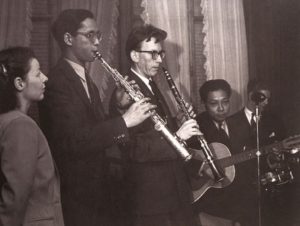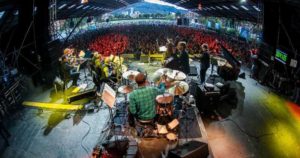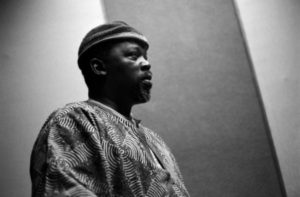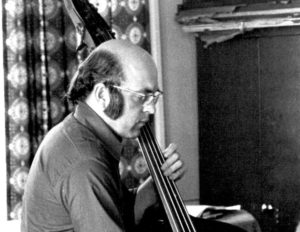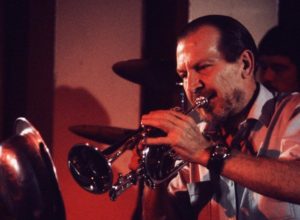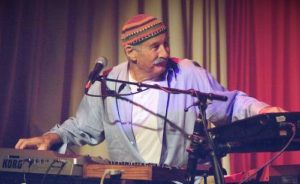Jazz in Switzerland
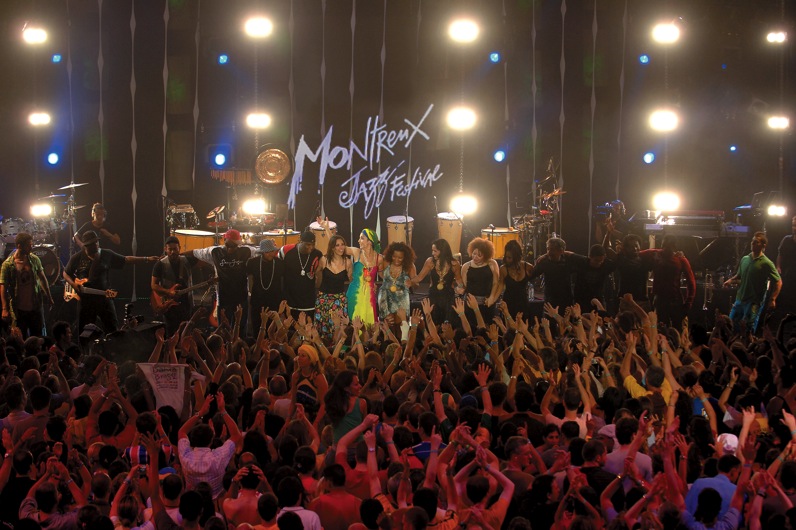
Appreciation for jazz in Switzerland came early from an authoritative source, the conductor Ernest Ansermet (1883-1969), who wrote in admiration of Will Marion Cook’s Sycnocpated Orchestra and in particular Sidney Bechet in the Revue Romande in 1919. His opinion is likely to have been an outlier among the older generation, though the younger generation of musicians were certainly in agreement. Influenced by the dance orchestras of Paul Whiteman, Jack Hylton, Jean Goldkette and Lew Stone who could be heard prominently on the radio, homegrown dance bands like the Illarez Orchestra and pianist Jean Yatov‘s band began to appear in Switzerland from the early 1920s. The first Swiss jazz band to record were the Lanigiro Syncopating Melody Kings. Founded in 1924 by drummer Roger Beuret (1910-2005), his banjo playing brother Willy Beuret, and the pianist Oswald Wagner. Probably the first American jazz band to appear in Switzerland were pianist Sam Wooding’s Chocolate Kiddies in 1926, a band that featured cornettist Tommy Ladnier, trumpeter Bobby Martin, and saxophonists Gene Sedric and Willy Lewis.
The 1930s were an exciting time for jazz in Switzerland. Louis Armstrong visited in 1935, influencing a generation of trumpet players, including Gugu Dupuis (1917-2013). Coleman Hawkins had a similar impact on musicians who heard, and got the chance to play with him, as he lived for some time in Geneva from 1936 to 1937. In 1938, ex-Sam Wooding trumpeter Bobby Martin returned to Switzerland with his own band – a group that included ex-Fletcher Henderson drummer Kaiser Marshall, pianist Ram Ramirez and the saxophonist and clarinettist Glyn Paque (1906-1953). Paque elected to remain in Switzerland, forming his own group, The Cotton Club Serenaders.
Swiss bandleader Teddy Stauffer (1909-1991) had international success with his band, the Original Teddies, which he based in Germany until he fled Europe for Mexico during the Second World War. In contrast, the Swiss jazz scene of the 1930s did also benefit from an influx of musicians escaping Nazi-occupied neighbouring countries. Philippe Brun (1908-1994), a leading French bandleader relocated to Switzerland from 1941 to 1944, employing Swiss musicians like saxophonist Eddie Brunner (1912-1960), drummer Stuff Combe (1924-1986) and Swiss-based German saxophonist/clarinettist Ernst Höllerhagen (1912-1956).
Höllerhagen was another who had escaped to neutral Switzerland, finding work (with Stauffer among others) and peace for a time. Brunner also worked with Teddy Stauffer, taking over the Teddies and turning it into a sextet, after Stauffer left for USA (and a brief marriage to Hedy Lamarr) and then Acapulco. From 1943 to 1948 pianist Fred Böhler (1912-1995) led a big band, which featured a number of key figures from Switzerland’s swing era – pianist Rio de Gregori (1919-1987), Gugu Dupuis, Glyn Paque and Hazy Osterwald. Osterwald (1922-2012) worked as an arranger and trumpeter for Böhler, before leading his own long lasting ensemble from 1944, in which Höllerhagen and Combe were among the alumni. Django Reinhardt made a failed attempt to escape Vichy France for Switzerland, while his ex-bandmate guitarist Marcel Bianchi (1911-1998) was more successful, arriving in the early 1940s. He played with Böhler’s orchestra from 1944, making several recordings with the band. Rio de Gregori led his own band after the war, which included Combe and another Osterwald alumnus, the saxophonist Flavio Ambrosetti (1919-2012).
In a country of around 3 to 5 million people (from 1900 to 1960), it is perhaps unsurprising that we seem the same pool of professional, improvising jazz musicians – de Gregori, Paque, Ambrosetti, Combe, Höllerhagen – all shifting around among the leading swing bands, those of Böhler, Osterwald, Brun, Stauffer and Brunner. The best recordings of Swiss jazz of the 1930s and 1940s will invariably feature some of these players and bands.
During the 1950s and 1960s, as could be seen elsewhere in Europe, two strains of jazz ran concurrently with little intermingling – Dixieland and the more modern post bop and cool jazz sounds. The former had proponents like the Harlem Ramblers, The Tremble Kids, the New Orleans Wild Cats and the band of trombonist Raymond Droz (1934-2000). The Tremble Kids featured trumpeter Oscar Klein (1930-2006) and drummer Charly Antolini (born 1937). Antolini was among the first Swiss jazz musicians to earn a truly international reputation, and he has worked in a diverse range of settings from swing to funk, and played with Benny Goodman, Dick Morrissey and Albert Mangelsdorff among many others.
Post bop and ‘cooler’ sounds could be heard in the music of Ambrosetti. The saxophonist’s 1960s quintet included his son, trumpeter Franco Ambrosetti (born 1941) and the pianist George Gruntz (1932-2013), both of whom would be leading figures in European jazz over the next decades. Before we get to their impressive careers however, it’s worth noting a few more influential figures of the Swiss jazz scene of the 1950s and 60s. Modelled on the Modern Jazz Quartet, the Metronome Quintet featured Uli Staub (1934-2012) on vibraphone, pianist Martin Hugelshofer (born 1933) and saxophonist Bruno Spoerri (born 1935), another musician who would go onto have a greater impact in his future projects. Vibraphonist and pianist Remo Rau (1925-1987) was a key figure in Swiss jazz, not only as a musician, but he as a promoter. He ran the legendary club, Café Africana, which brought musicians like Abdullah Ibrahim, Chris McGregor and Dudu Pukwana to Zurich during the early 1960s. Singer-pianist (and occasional accordionist) Elsie Bianchi (1930-2016) won awards at the Zurich Jazz Festival in the early 1950s, before touring and recording in USA, where she would eventually settle with her husband (and bassist) Siro Bianchi. A few years later, another young musician to pick up an award at the Zurich Jazz Fesitival was the pianist Patrick Moraz (born 1948), who would go onto join Yes and The Moody Blues.
Drummer Daniel Humair (born 1938) move to Paris aged 20, and has enjoyed a stellar career, working with Martial Solal, Stephane Grappelli, Phil Woods and recording prolifically as a bandleader. He has worked frequently with fellow Swiss musicians Franco Ambrosetti and George Gruntz. The three of them started The Band together in 1972, which from 1978 continued as the George Gruntz Concert Big Band, turning the pianist/composer into one of jazz’s most important bandleaders, employing some of the finest American and European musicians, including Eberhard Weber, Benny Bailey, John Scofield and Palle Mikkelborg. Ambrosetti’s own prolific career as a bandleader has seen him call upon the talents of Geri Allen, Michael Brecker, Kenny Kirkland, Kenny Barron, Miroslav Vitouš and John Abercrombie as well as Humair and Gruntz. A Swiss saxophonist who worked with both Gruntz and Ambrosetti was Andy Scherrer (1946-2019), who was perhaps most influential as a jazz educator, teaching for almost four decades at the Swiss Jazz School in Bern, Europe’s first jazz school, founded in 1967.
The Café Africana house band was a hard bop quintet, led by Remo Rau, and which included Metronome Quintet sax player Bruno Spoerri and trumpeter Hans Kennel (1939-2021). By the late 1960s, the two horn players were both exploring new sounds. Seeking inspiration from folk music, early blues, jazz rock and new electronic instruments, they put together a larger group, the Jazz Rock Experience, which also included future star of freeform jazz, pianist Irène Schweizer (born 1941). Kennel was also a key figure in the free jazz/jazz rock sextet, Magog, which grew out of a trio led by pianist Klaus Koenig (born 1936). Kennel went on to form the more straightahead Jazz Community in 1977, which included Magog trombonist Paul Haag (born 1942). Another popular fusion group of the late 1970s was Tetragon, led by by ex-bopper, alto player Peter Candiotto (born 1937). By this time, Switzerland had become an important destination in the world of jazz and popular music in general, through the creation in 1967 of the Montreux Jazz Festival by Claude Nobs (1936-2013).
Irène Schweizer was leading her own trio from 1968 with Swiss drummer Pierre Favre (born 1937). She went on to become a key figure in jazz’s avant garde, working throughout the 1970s with like-minded European players like Han Bennink, Evan Parker, Derek Bailey, Peter Brotzman and Manfred Schooff, as well as with the European Women’s International Improvising Group from 1983. Ambrosetti, Humair and Gruntz remained towering figures throughout the 1980s, while a new generation of musicians was also making its mark. Trombonist Robert Morgenthaler (born 1952) and saxophonist Heiner Althus (born 1953) formed the Swiss Jazz Quintet in 1976, which recorded several albums into the 1980s. Trumpeter Erik Truffaz (born 1960) was leading his own groups from 1982, kicking off a musical partnership with drummer Marc Erbetta (born 1963) that stands at four decades and counting. Truffaz’s jazz fusion groups attracted international attention with a string of performances at Montreux and other Jazz Festivals in the early 1990s, and he soon signed for Blue Note Records.
Continuing a tradition of world class female pianists from Switzerland, Sylvie Courvoisier (born 1968), has received wide recognition in jazz circles, particular since her move to Brooklyn in 1998. She has recorded albums for ECM, Enja and Intakt, often with her husband violinist, Mark Feldman, or with her trio since 2014 with Drew Gress and Kenny Wollesen. Another Swiss jazz musician who has built his career in the United States is harmonica player, Grégoire Maret (born 1975), who has worked with Steve Coleman, Pat Metheny, Cassandra Wilson and countless others. The German label, ECM has since the 2000s signed a number of Swiss jazz artists besides Courvoisier: Nik Bärtsch (born 1971) weaves contemporary classical music into his compositions for his band Ronin, while Swiss-Albanian jazz singer Elina Duni (born 1981) has been recording for ECM since 2012, often with pianist Colin Vallon (born 1980), whose own trio has released three albums with the label. Many of these artists found a venue worthy of their talents in Switzerland’s standout jazz venue, Moods, which opened in Zurich in 1992.
Away from ECM, many more Swiss jazz artists have attained international recognition in the last couple of decades, including three more noteworthy singers – San Fransisco-born, Swiss American Erika Stucky (born 1962) first attracted attention for her work with George Gruntz, and has gone onto forge a unique and idiosyncratic style combining cabaret, jazz, Alpine folk, classical and the avant garde. Andreas Schaerer (born 1976) is a freeflowing jazz singer with an impressive range, influence by Bobby McFerrin, with whom he has collaborated. More recently, talented singer Lucia Cadotsch (born 1986) has been drawing acclaim from jazz audiences and media across Europe. Creative and collective piano trio VEIN (Florian Arbenz, Thomas Läns and Michael Arbenz) have been popular festival and club draws in- and outside of Switzerland, and they have teamed up with like Dave Liebman, Greg Osby and Andy Sheppard along the way.
Inevitably, this is not a complete survey and I can already see several serious ommissions – Rene Weiss, Kitty Ramon, Pierre Cavalli, Robi Weber, Othella Dallas, the Swiss Jazz Orchestra, Thierry Lang – and there will be countless more that I haven’t even noticed. Feel free to contact me and let me know where you feel I’ve gone especially wrong.
